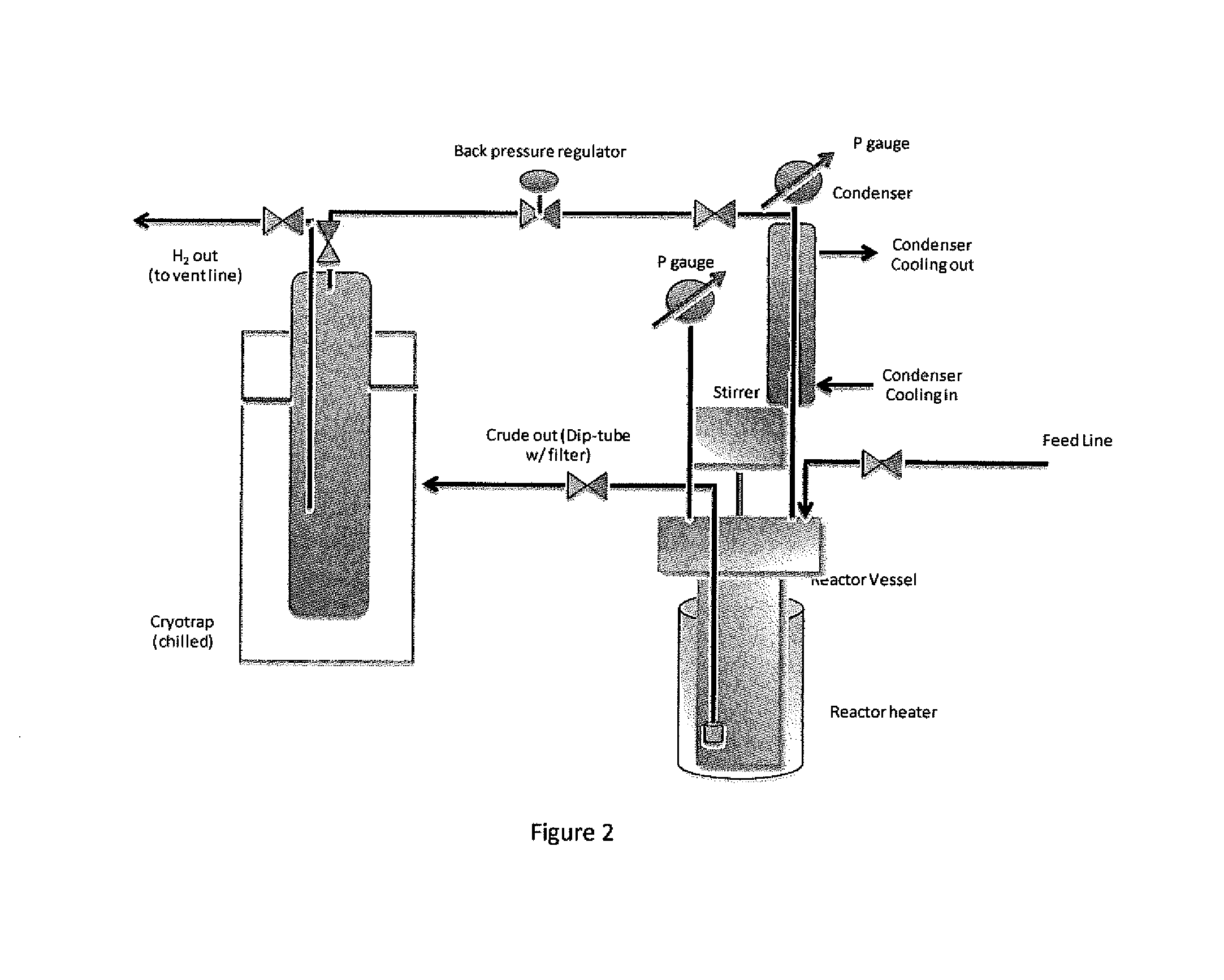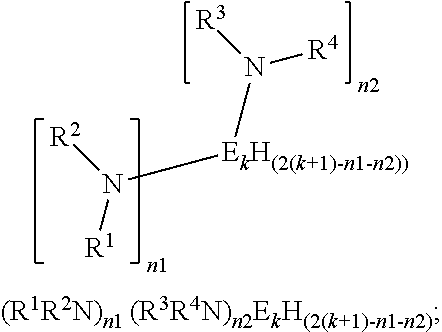Halogen free syntheses of aminosilanes by catalytic dehydrogenative coupling
a catalytic dehydrogenation and aminosilane technology, applied in chemical/physical processes, metal/metal-oxide/metal-hydroxide catalysts, group 3/13 element organic compounds, etc., can solve the problem of limiting the scope of the reaction to base-compatible substrates, clogging the exhaust line, and products contaminated with halogens such as chlorine and aminohalogens
- Summary
- Abstract
- Description
- Claims
- Application Information
AI Technical Summary
Benefits of technology
Problems solved by technology
Method used
Image
Examples
example 1
Synthesis of Diisopropylaminodisilane “DIPADS”
[0058]
Si2H6+(iPr)2NH═(iPr)2NSi2H5+H2
[0059]DIPADS (diisopropylaminodisilane also known as N,N-diisopropyl, N-disilylamine) was synthesized in a pressurized reactor vessel by the reaction between disilane and diisopropylamine catalyzed by commercially available Ruthenium on carbon in n-octadecane as a solvent: A 0.3 L autoclave (reaction vessel) equipped with a mechanical stirrer, a thermocouple, a pressure gauge and a pressure transducer and 3 metering valves, FIG. 1, was charged with 6 g (0.003 mmol of ruthenium) of 5% weight ruthenium on carbon catalyst. The reactor was then heated under dynamic vacuum at 125° C. for 3 hr. activating the catalyst After cooling down to room temperature, the reactor was filled with helium at 1 atmosphere (“atm”) pressure, sealed and disconnected from the manifold. Inside a glove box, 20.7 g (0.205 mol) of diisopropylamine and 75 g of n-octadecane were added to the reactor. Then, the reactor was taken out...
example 2
[0062]The solvent free synthesis of chlorine and aminochlorine free DIPADS in a pressurized reactor from disilane and diisopropylamine catalyzed by commercially available Ruthenium on carbon. A 0.3 L autoclave equipped with a mechanical stirrer, a thermocouple, a pressure gauge and a pressure transducer and 3 metering valves was charged with 6 g (0.003 mmol of ruthenium) of 5% weight ruthenium on carbon catalyst. The reactor was then heated under dynamic vacuum at 125° C. for 3 hr. After cooling down to room temperature, the reactor was filled with 1 atm. of helium, sealed and disconnected from the manifold. Inside a glove box, 20.7 (0.205 mol) of diisopropylamine were added. Then, the reactor was taken out from the glove box and reconnected to the manifold and it was cooled down to −130° C. in a liquid nitrogen bath. 30 g of disilane (0.453 mol) were transferred to the reactor through the manifold. The reactor was then heated up to 150 TC. After stirring at 400 rpm for 24 hr, press...
example 3
[0067]A method for synthesizing chlorine free trisilylphosphine in a pressurized reactor from silane and phosphine catalyzed by commercially available Ruthenium on carbon would comprise. A 0.3 L autoclave equipped with a mechanical stirrer, a thermocouple, a pressure gauge and a pressure transducer and 3 metering valves is charged with 10 g (0.005 mol of ruthenium) of 5% weight ruthenium on carbon catalyst. The reactor is then heated under dynamic vacuum at 125° C. for 3 hr. After cooling down to room temperature, the reactor is filled with 1 atm. of helium then cooled down to −130° C. in the liquid nitrogen bath. 15 g (0.44 mol) of phosphine and 50 g (1.6 mol) of silane are transferred to the reactor through the manifold. The reactor is then heated up to 150° C. After stirring at 400 rpm for 23 hr, the reactor is cooled down to RT. Volatiles are cryotrapped in a SSLB. The reaction vessel pressure will drop to about 45 Torr. The trisilylphosphine is recovered from the reactor vessel...
PUM
| Property | Measurement | Unit |
|---|---|---|
| Temperature | aaaaa | aaaaa |
| Temperature | aaaaa | aaaaa |
| Fraction | aaaaa | aaaaa |
Abstract
Description
Claims
Application Information
 Login to View More
Login to View More - R&D
- Intellectual Property
- Life Sciences
- Materials
- Tech Scout
- Unparalleled Data Quality
- Higher Quality Content
- 60% Fewer Hallucinations
Browse by: Latest US Patents, China's latest patents, Technical Efficacy Thesaurus, Application Domain, Technology Topic, Popular Technical Reports.
© 2025 PatSnap. All rights reserved.Legal|Privacy policy|Modern Slavery Act Transparency Statement|Sitemap|About US| Contact US: help@patsnap.com



